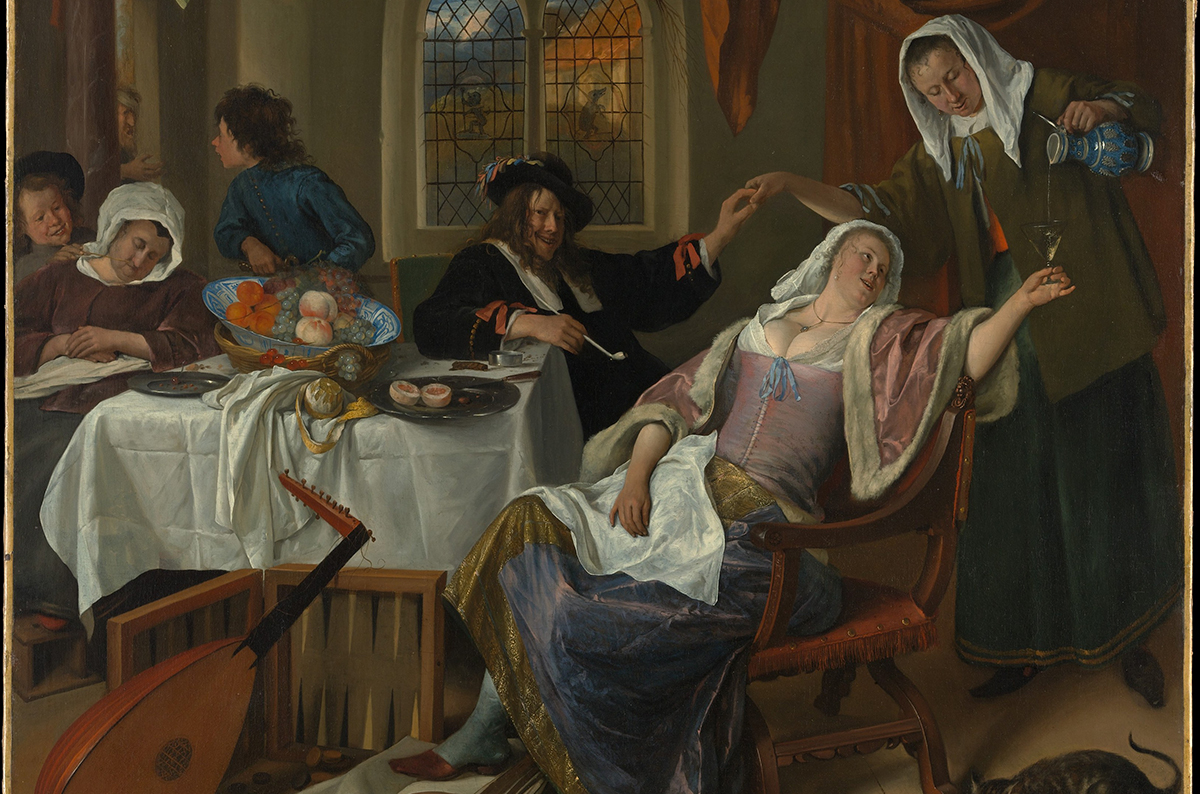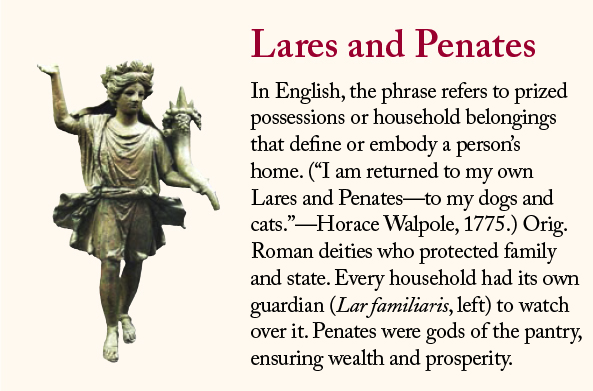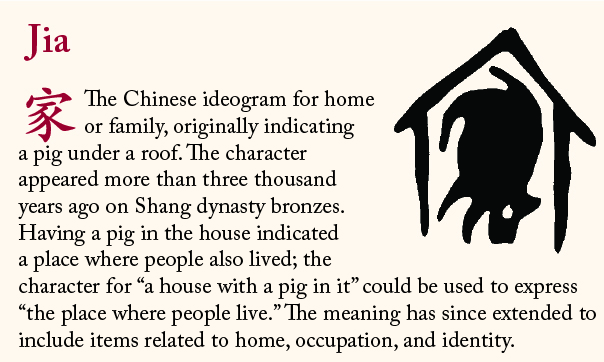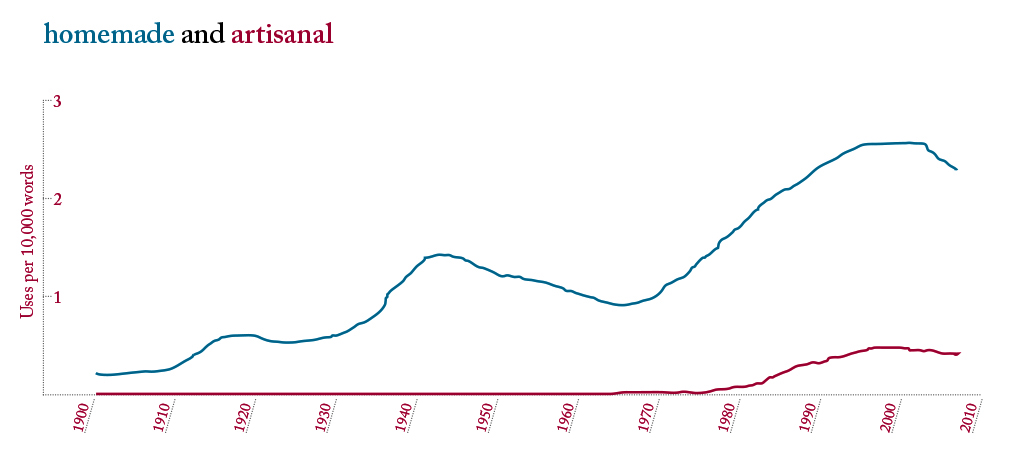
The Dissolute Household, by Jan Steen, c. 1663–64. The Metropolitan Museum of Art, Jack and Belle Linsky Collection, 1982.
apartment: A portion of a house or building consisting of a suite or set of rooms. From French appartement, Italian appartamento, a separated place; from Latin ad, to, and partire, divide, share.
attic: The top story of a building, under roof beams, when there are more than two stories above ground. From French attique, Greek Attikos, Athenian, of Attica. Attic order referred to decorative columns in a low story above a building’s main facade, often used around Athens. Later came to convey the space enclosed by such a structure.
canny: Sagacious, judicious; in Scottish English, quiet, easy, snug. Not found before 17th cent.
castlet: A small castle.
cellar, in the: Drunk. “Down among the wines and spirits.”—P.G. Wodehouse
curfew: A restriction on the movement of inhabitants of an area for a specified period. A medieval regulation by which, at a fixed hour in the evening, fires were extinguished. From Old French covre-feu, cover fire.
doghouse, in the: (U.S. slang) In disgrace; out of favor.

doormat: A heavy and unaccustomed beard that soldiers brought back from the Crimean War (1853–1856), starting the English beard movement.
dwell: To abide or continue for a time in a place, state, or condition. Also, to go up as in a cloud; to go astray. (Obs.) To lead into error, mislead, delude; to stupefy. Corresponding to Old High German twellan, Old Norse dvęlja, to retard, delay, Middle Dutch dwellen, to stun, make giddy, perplex. From the Aryan root dhwel, dhul; appears in Sanskrit dhwr, dhūr, to mislead, deceive.
economics: From Greek oikonomikos, the art of managing an oikos, the authoritarian household that was the organizational center of life in ancient Greece. The oikos referred not merely to the family but to all the people of the household along with the land and its goods.
focus: A hearth. From Latin focus, hearth, fireplace; fig. home, family; of unknown origin. Used in postclassical times for fire and disease; used in the mathematical sense of a point of convergence by Kepler in 1604. First recorded use for the transfer to center of activity or energy, 1778.
Heimat: Lit. homeland, but the meaning extends beyond genealogical origins, lying between the sense of Heim (home, where one stays and is settled) and Vaterland (fatherland, place of birth); implies belonging.
hearth rug: A fool or simpleton. Rhyming slang for mug (1910).
homely: Of or belonging to a household or home. Also, of plain appearance; unattractive.
home plate: In baseball, the base next to which a batter stands (1869). Formerly a circle or square, typically of stone or marble; in the 1880s rules stipulated a square of whitened rubber; in 1900 a pentagonal shape was adopted. Also, the last of four notional stages of sexual activity, usually characterized as an act of sexual intercourse.
homeschool dropout: A homeschooler who kills one or both of his or her parents.

home-wrecker: A person who ruins family, home, or relationship, spec. one blamed for the breakup of a marriage, usually because of his or her affair with one of the partners. “And here we are again: the bald husband, the rural plute, and this dashing blade, this home-wrecking poet.”—William Faulkner
house: “A hollow edifice erected for the habitation of man, rat, mouse, beetle, cockroach, fly, mosquito, flea, bacillus, and microbe.”—Ambrose Bierce, The Devil’s Dictionary
house ape: A small child.
hut: A dwelling of rude or mean construction, usually of a smaller size than a house. From German hütte, perhaps related to Old English hýdan, to hide. First used, 17th cent.
kitchen: “A fat kitchen makes a lean will.”—Benjamin Franklin
long home: The grave. “Man goeth to his long home, and the mourners go about the streets.”—Ecclesiastes 12:5
luak: Among the Dinka of South Sudan, a shrine also used as a structure for cattle; represents marriage, married life, and procreation.
McMansion: A modern house built on an imposing scale and regarded as ostentatious and lacking in architectural integrity. First use, 1990.
mortgage: An arrangement or transaction whereby benefit is acquired at the expense of exposure to some (esp. future) risk. From Latin mors, mortis, mortal; from mortuus, dead, and vadium, pledge.
Murphy bed: A bed that can be folded away, esp. into a wall. From William Lawrence Murphy (1876–1959), U.S. manufacturer who produced original design.
pad: A person’s residence, usually an apartment. Orig. slang among American criminals meaning a place to sleep, use narcotics, or entertain a prostitute. First recorded use, 1914.
residentarian: A person given to remaining at the table.

slum: An area of a city where poor people live and buildings are in a state of disrepair. Originally a cant word of unknown origin meaning room, esp. back room. First use, 1825.
sofa: A long upholstered seat usually with arms and a back. Orig. a raised carpeted floor. From Italian sofa, Arabic suffa, carpet, divan.
Torschloßpanik: German for a fear of time running out; lit. a door-closing panic. Orig. medieval peasants’ fear of being outside city gates past nightfall.
umkhaya: South African English for homeboy, from Xhosa. A man or youth from one’s hometown, also a male from a background similar to one’s own. From um-, prefix denoting animate being, and khaya, home abode, place of origin.
wigwam: A lodge, cabin, tent, or hut of North American Indians formed of bark, matting, or hide stretched over a frame of poles converging at the top. From Ojibwa wigwaum, wigiwam, variant of Algonquin weekuwom, wikiwam, their house.
window: The vulgar English pronunciation is windor, as if from the Welsh gwyntdor, wind-door.
Explore Home, the Winter 2017 issue of Lapham’s Quarterly.